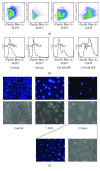Staurosporine Induces the Generation of Polyploid Giant Cancer Cells in Non-Small-Cell Lung Carcinoma A549 Cells
- PMID: 30406001
- PMCID: PMC6199859
- DOI: 10.1155/2018/1754085
Staurosporine Induces the Generation of Polyploid Giant Cancer Cells in Non-Small-Cell Lung Carcinoma A549 Cells
Abstract
Cultivation of A549 non-small-cell lung carcinoma (NSCLC) cells in the presence of staurosporine (SSP) leads to a reduction or a lack of proliferation in a concentration-dependent manner. This inhibition of proliferation is accompanied by the generation of polyploid giant cancer cells (PGCCs) that are characterized by cell flattening, increased cell size, polyploidy, and polynucleation as determined by crystal violet staining, BrdU and DiI labelling, and flow cytometry as well as video time-lapse analysis. Continuous SSP treatment of A549 cells can preserve PGCCs for at least two months in a resting state. Upon removal of SSP, A549 PGCCs restart to divide and exhibit a proliferation pattern and cellular morphology indistinguishable from cells where PGCCs originally derived from. Thus, SSP-treated A549 cells represent a simple and reliable experimental model for the reversible generation of PGCCs and their subsequent experimental analysis.
Figures






References
MeSH terms
Substances
LinkOut - more resources
Full Text Sources
Medical

